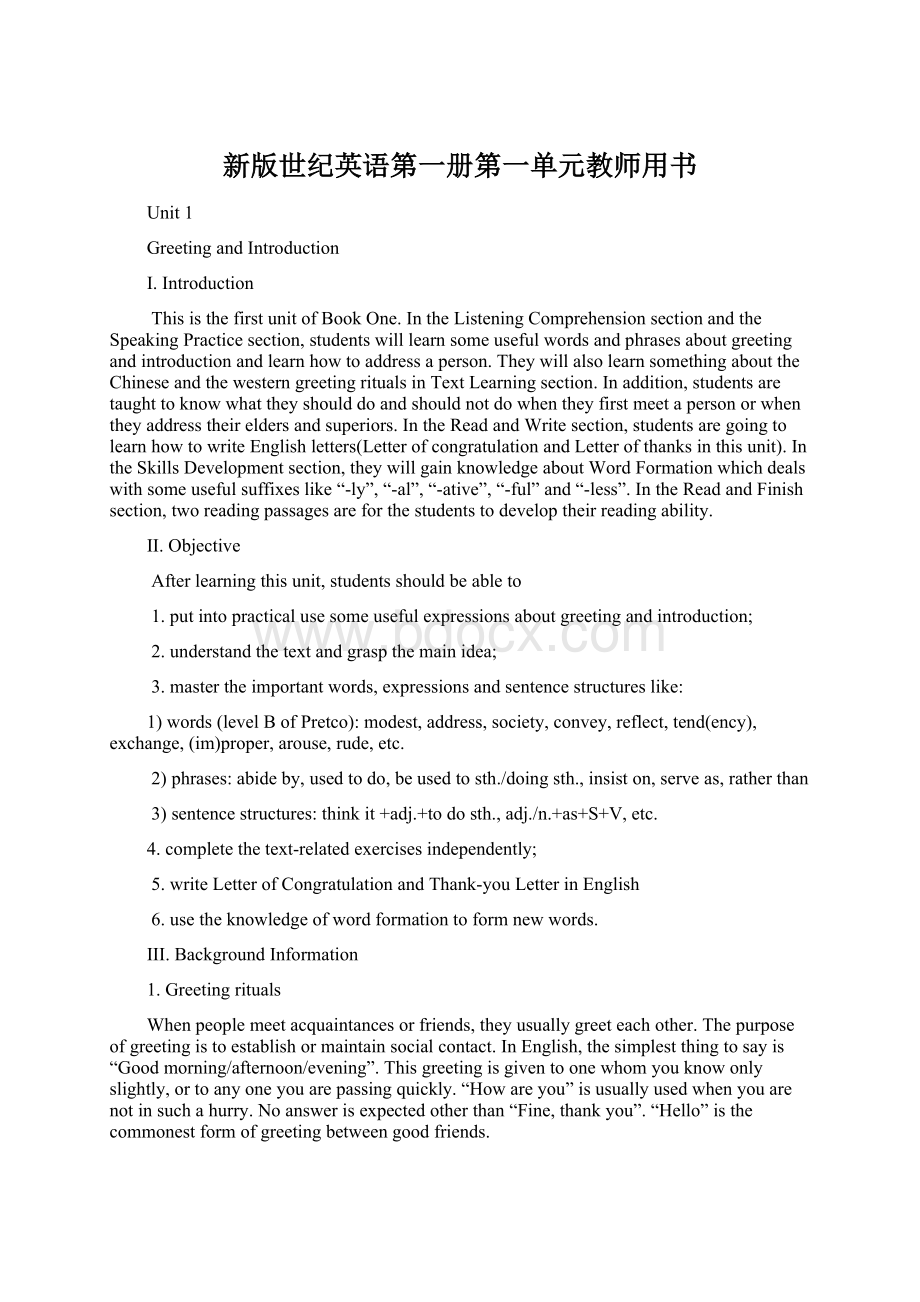新版世纪英语第一册第一单元教师用书.docx
《新版世纪英语第一册第一单元教师用书.docx》由会员分享,可在线阅读,更多相关《新版世纪英语第一册第一单元教师用书.docx(29页珍藏版)》请在冰豆网上搜索。

新版世纪英语第一册第一单元教师用书
Unit1
GreetingandIntroduction
I.Introduction
ThisisthefirstunitofBookOne.IntheListeningComprehensionsectionandtheSpeakingPracticesection,studentswilllearnsomeusefulwordsandphrasesaboutgreetingandintroductionandlearnhowtoaddressaperson.TheywillalsolearnsomethingabouttheChineseandthewesterngreetingritualsinTextLearningsection.Inaddition,studentsaretaughttoknowwhattheyshoulddoandshouldnotdowhentheyfirstmeetapersonorwhentheyaddresstheireldersandsuperiors.IntheReadandWritesection,studentsaregoingtolearnhowtowriteEnglishletters(LetterofcongratulationandLetterofthanksinthisunit).IntheSkillsDevelopmentsection,theywillgainknowledgeaboutWordFormationwhichdealswithsomeusefulsuffixeslike“-ly”,“-al”,“-ative”,“-ful”and“-less”.IntheReadandFinishsection,tworeadingpassagesareforthestudentstodeveloptheirreadingability.
II.Objective
Afterlearningthisunit,studentsshouldbeableto
1.putintopracticalusesomeusefulexpressionsaboutgreetingandintroduction;
2.understandthetextandgraspthemainidea;
3.mastertheimportantwords,expressionsandsentencestructureslike:
1)words(levelBofPretco):
modest,address,society,convey,reflect,tend(ency),exchange,(im)proper,arouse,rude,etc.
2)phrases:
abideby,usedtodo,beusedtosth./doingsth.,insiston,serveas,ratherthan
3)sentencestructures:
thinkit+adj.+todosth.,adj./n.+as+S+V,etc.
4.completethetext-relatedexercisesindependently;
5.writeLetterofCongratulationandThank-youLetterinEnglish
6.usetheknowledgeofwordformationtoformnewwords.
III.BackgroundInformation
1.Greetingrituals
Whenpeoplemeetacquaintancesorfriends,theyusuallygreeteachother.Thepurposeofgreetingistoestablishormaintainsocialcontact.InEnglish,thesimplestthingtosayis“Goodmorning/afternoon/evening”.Thisgreetingisgiventoonewhomyouknowonlyslightly,ortoanyoneyouarepassingquickly.“Howareyou”isusuallyusedwhenyouarenotinsuchahurry.Noanswerisexpectedotherthan“Fine,thankyou”.“Hello”isthecommonestformofgreetingbetweengoodfriends.
Ifyouarewearingahatwhichcanbetakenboldofeasily,itiscustomarytoraiseitslightlyoffyourheadwhenyougreetagirlorawoman.
Itiscustomarytoshakehandswhenyoufirstmeetsomeone.Usuallyfriendsshakehandswhentheymeetafternothavingseeneachotherforsometime.However,itisnotnecessarytoshakehands.Englishmendoshakehandswitheachother,butaslittleaspossible.Theyneverhugorkissothermen.ManyAmericanshugeachotherasaformofgreeting.Girlstendtohuglongerandguysjusthavea“half-hug”.
Itisalwaysgoodformtousethenameofthepersonyouaregreeting.Youmightsay,“Goodmorning,Mr.Black”or“Hello,Franklin”.Aperson’ssurnameshouldbeusedunlessheisgoodfriendorschool-mate.Oneneveraddresseshisteacherbyhisfirstname,eitherinspeechorinwriting.Ifone’steacher’snameisJohnSmith,itisnotpropertosay“John”.Andoneneverspeakstoone’steacheras“Teacher”.Itisquitepropertosay“Sir”toamanbutifyourteacherisawoman,youmustusehersurname.
Inintroducingtwopeople,thegeneralruleistointroduceotherpeopletothepersonyouwishtohonor.TheoldarehonoredintheWestasinChina.WomenhavebeenhonoredintheWestsincethedaysofknighthood.
Amanalwaysrisesforanintroduction,exceptthatitissometimesallrightforanelderlymantoremainseatedwhenayoungmanisintroducedtohim.Thehostessalwaysrisesforanintroduction.Youshouldbecautioustoaskawomanprivatequestions.However,relaxingtalksaboutherjoborfamilylifewillneverputyouintodanger.Sheisusuallygladtoofferyousomeadvicehowtocookorgetaccustomedtolocallife.
Ifyouwanttomeetsomeone,itisbettertoaskafriendwhoknowshimtointroduceyou.Butsometimesatameetingorgatheringitisallrighttointroduceyourselftoafellowstudent,ortooneofthesamesexandposition.
InChina,wealwayssay“Haveyoueatenyet?
”“Whatareyougoingtodo?
”or“Wherehaveyoubeen?
”toshowourconsideration.Thesequestionsarejustsuperficialinquiriesthatdon’trequirealiteral-minded,detailedanswer.Simplyanswer“Yes”,evenifyouhaven’tactuallyeatenorsimplysmileandsay“Thankyou”.
SometimestheChinesenodasaninitialgreeting.Itiscommonsocialpracticetointroducethejuniortothesenior,orthefamiliartotheunfamiliar.Whenyoubeginatalkwithastranger,thetopicssuchasweather,food,orhobbiesmaybegoodchoicestobreaktheice.Toaman,achataboutcurrentaffaires,sports,stockmarketorhisjobcanusuallygoonsmoothly.Membersofthesamesexmayholdhandsinpublicinordertoshowfriendliness.
2.Businesscards
Business/namecardsareubiquitousinChinesebusinessandwillalmostalwaysbeexchangeduponmeetingastrangerinsuchacontext.Businesscardsusuallyincludethebearer’sname,professionandtitle,address,telephonenumber,fax,postalcode,e-mailaddressandsomeotherusefulinformationandpersonaldata.Toaforeignfriend,ChineseshouldremembertopresentacardeitherwithanEnglishversionorwritteninEnglish,becausemostEnglishspeakersdon’thavecompetenceinreadingChinese.
3.EnglishnamesandChinesenames
AcommonEnglishnameisusuallycomposedoftwoorthreeparts:
thefirstnameisalsocalled
forename.IfthepersonisaChristian,hisfirstnamewillbegivenathisbaptism,soitisalsocalledthegivennameortheChristianname.Middlenameisthesecondgivenname.Whenwritten,middlenameisoftenshortenedtotheinitialletter.Surnameisoftenthefather’sfamilyname,soitisalsocalledfamilynameorlastname.Forexample:
AnneLouiseStrong,GeorgeW.Bush.Thesenamesarewrittenandspokenwiththegivennamefirstandthefamilynamelast.SoJohnSmith’sfamilynameisSmith,notJohn.
InChinese,theorderandtheuseoffirstnameandlastnamearesomewhatdifferentfromthe
westerners’names.Surnamecomesfirstandthenthegivenname.Andpeopleliketoadd“Xiao(Little)”beforetheirfamilyname,suchas“XiaoZhou”,“XiaoDong”andsoon.Mostpeopleshouldbeaddressedwithatitleandtheirlastname.Ifapersondoesn’thaveatitle,use“Mr.”,“Madam”,“Miss”,plusthelastname.AmarriedChinesewomanusuallyretainshermaidenname.Shewilluseherhusband’ssurnameonoccasionsforformaladdressingonly.Ifyoudon’tknowwhetherawomanismarriedornot,itisbettertoaddressher“Ms.X”.
IV.ClassPresentation
SectionAListeningandSpeaking
ListeningComprehension
TapescriptsandKeys
PartA
Listentothefollowingsentencesonceandgivethebestresponses.
1.Howdoyoudo,Mr.Green?
(A)
A.Fine,thankyou.
B.Fine.Andyou?
C.Allright.
D.No,thanks.
.
2.Hello,Jack.Verypleasedtomeetyou.(B)
A.Ofcourse.CanIhelpyou?
B.Pleasedtomeetyou,too.
C.I’mquitefine.Whataboutyou?
D.Whyareyouhere?
3.Goodafternoon,Mr.Thomas.Welcometoourcollege.(D)
A.Goodafternoon,MissLi.MynameisThomas.
B.Oh,mayIknowwhereyou’refrom?
C.Thankyou.You’realsowelcome.
D.Thankyou.Nicetomeetyou.
4.Longtimenosee.Howiseverything?
(A)
A.OK.Whataboutyou?
B.Haven’tseenyouforages.
C.Verykindofyoutosayso.
D.Thanks.I’mgettingonwellwithmystudy.
5.AllowmetointroducemyfriendTom?
(B)
A.Letmeintroduceyoutohimfirst.
B.OK,sure.
C.I’msorry.Ihavesomethingimportanttodo.
D.Don’ttroubleyourself.
6.Excuseme,mayIknowyourname?
(B)
A.Nevermind.
B.Certainly.
C.Itdoesn’tmatter.
D.It’sallright.
7.Morning,sir.MayIhelpyou?
(C)
A.Yes,nicetomeetyou.
B.Yes,I’mgladtohaveawalkwithyou.
C.Yes,I’dliketochangesomeHKdollars.
D.Yes,butI’mafraidyoucan’t.
8.Ihatetosay“Goodbye”,butImustbegoingsoon.(B)
A.Nicetomeetyou.
B.Haveagoodday.
C.Don’tbother.
D.Itdoesn’tmatter.It’sstillearly.
9.Jenny,youlookmorebeautifultoday.Whatanicedress.(A)
A.Verykindofyoutosayso.
B.Idon’tthinkso.
C.Nicetalkingwithyou.
D.Ilovetohearthat.
10.Alovelyday,isn’tit?
(B)
A.Yes.TodayisSunday.
B.Yes.Itcertainlyis.
C.No,it’sabouttorain
D.Yes.It’stendegrees.
PartB
Listentothedialoguesonceandanswerthequestions.
11.M:
Hi,Mary.Howareyouthesedays?
(B)
W:
Oh,fine.Whataboutyou?
Q:
Whoarethey?
A.Strangers.
B.Acquaintances.
C.Couples.
D.Roommates.
12.M:
It’squitewarmtoday,isn’tit?
(C)
W:
Yes,itis.
Q:
Whatdoesthemanmeantodobysayingthat?
A:
Toaskthewomantogoswimming.
B:
Toexpresshissatisfactionwiththeweather.
C.Tobeginaconversation.
D.Toaskthewomantotakeoffherovercoat.
13.M:
Jane,howshouldIgreetmynewEnglishteacherwhenImeethimtomorrow?
(B)
W:
Oh,it’seasy.I’llteachyou.
Q:
Whatwillthewomanteachthemantosay?
A.Hi,Prof.Green.Howareyou?
B.Howdoyoudo,Prof.Green.I’mLiMing.
C.Goodmorning,Prof.Green.Ihaven’tseenyouforalongtime.
D.Hello,Prof.Green.What’sup?
14.M:
Whoisthatladyoverthere?
(C)
W:
SheisMr.White’swife.
Q:
HowshallweaddressMr.White’swife?
A.Misswhite.
B.MsWhite.
C.MrsWhite.
D.LadyWhite.
15.M:
Thankyouforyourdinner,Diana.SendmyregardstoJohn.(B)
W:
OK,Iwill.
Q:
Whendoesthedialoguemostprobablytakeplace?
A.WhenthemanarrivesatDiana’shome.
B.WhenthemanleavesDiana’shome.
C.WhenthemanishavingdinnerwithDiana.
D.Whenthemanfinishesdinner.
PartC
Listentoarecorded